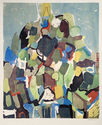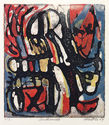
19th, 20th & 21st Century Fine Prints
707-546-7352 · fax 707-546-7924 · web: www.annexgalleries.com · email: artannex@aol.com
Clayton E. Walker Biography
Clayton E. Walker
American
1924–2008
Biography
Printmaker, painter, and designer Clayton E. Walker was born in Kentucky on July 28, 1924. Walker's interest in art peaked early, often using the house paints and brushes his father, a professional sign painter, owned to execute his own work on the barn door. He pursued art in school and, after the onset of World War II, he joined the army, keeping his sketchbook with him on his tours of duty. In 1944 Walker was sent to England to recuperate from a wound, and while there, he met and married Muriel. When they returned to the States, they moved to Ohio where Walker designed and built homes, and hung his work in galleries. It wasn't long before his work began selling. Inspired by the positive reaction, Walker decided to continue his education in the arts and in the late 1940 he entered the University of Toledo, where he received a master’s in painting and minor in art history. It wasn't long before he began teaching art in both private and community colleges, even venturing overseas to take up posts there, as well. In 1955, the Walkers traveled to England and Paris, where Clay attended the Ecole des Beaux Arts. It was there he met Picasso, who became a longtime friend and supporter of Walker's.
Walker soon began exhibiting both in the U.S. and internationally, and it wasn't long before his art was sought after in upper echelons of the art world. In addition to sell-out openings in galleries, acquisitions were made by the Museum of Modern Art, the Library of Congress, San Francisco Museum of Art, and the Butler Museum of Art. Artists such as Miro and Calder traded works with him; he began exhibiting with Picasso, Rauschenberg, Warhol, and other prominent artists. Meanwhile, as his commercial success flourished, his love of teaching never ceased, and took a post in Texas as art director at the San Antonio Art Institute in 1960. He remained there until 1963, when he and Muriel moved to Vista, California, designing and building his house and studio and taking up several teaching positions. This period proved to be a reflective one for the artist; he soon concluded he was overwhelmed by the commercial success he had been experiencing. By 1978 he made his last move, to Escondido in Southern California. Informed by the visual art he loved, he designed and built his last home and studio as a kind of retreat, a dynamic ranch style home complete with sprawling sculptural elements, and hung throughout with prints and paintings. He stopped exhibiting and for the next forty years viewings of his work were confined to his studio, by his closest friends.
Clayton E. Walker died in Escondido, California on March 1st of 2008.






